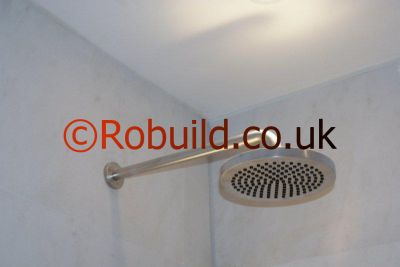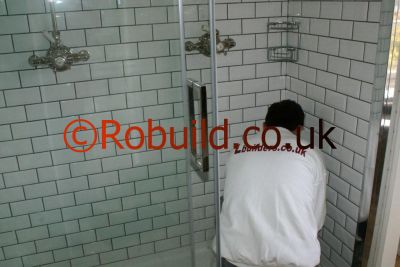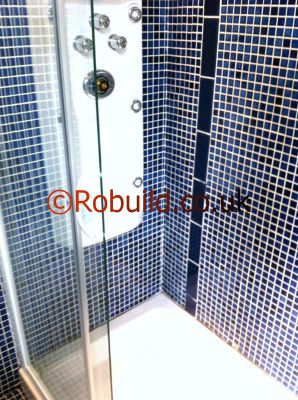INSTALLING A SHOWER
Showers are part of the modern bathroom, and can be fitted over the bath to save space, or in a separate cubicle.
Water Pressure for Showers
The most important requirement is that the hot and cold supply pipes to the shower must be under equal water pressure. With a cylinder storage hot water system, whether direct or indirect, hot water pressure comes from the main cold water storage cistern supplying the cylinder with water. The cold water supply to the shower must therefore also come from this cistern (or perhaps from a separate cistern at the same level);
it must not be taken direct from the cold water main. It is not safe to mix, in any plumbing appliance, water which comes direct from the main and water coming from a storage cistern. However, quite apart from the important question of legality, it is impossible to mix streams of water satisfactorily under such differing pressures. The shower will inevitably run either very hot or very cold, depending on which stream is the high pressure one. The cold water storage cistern must also be high enough above the shower sprinkler to provide a satisfactory operating pressure.
Best results will be obtained if the base of the cold water storage cistern is 1.5m (5ft) or more above the sprinkler. However, provided that pipe runs are short and have only slight changes of direction, a . reasonable shower can be obtained when the vertical distance between the base of the cistern and the shower sprinkler is as little as 1 m (39in). The level of the hot water storage tank in relation to the shower doesn’t matter in the least. It can be above, below or at the same level as the shower. It is the level of the cold water storage cistern that matters.
There is yet another design requirement for conventional shower installation which sometimes applies. This is that the cold water supply to the shower should be a separate 15mm branch direct from the cold water storage cistern, not as a branch from the main bathroom distribution pipe. This is a safety precaution. If the cold supply were taken as a branch from a main distribution pipe, then flushing a lavatory cistern would reduce the pressure on the cold side of the shower causing it to run dangerously hot. For the same reason it is best for the hot supply to be taken direct from the vent pipe immediately above the hot water storage cylinder and not as a branch from another distribution pipe, though this is rather less important. A reduction in the hot water pressure would result in the shower running cold. This would be highly unpleasant, although not dangerous.
Shower Mixers
Showers must have some kind of mixing valve to mix the streams of hot and cold water and thus to produce a shower at the required temperature.
The two handles of the bath taps provide the very simplest mixing valve. Opening the bath taps then mixes the two streams of water and diverts them upwards to a wallhung shower head or rose.

These very simple attachments work quite satisfactorily – provided that the design requirements already referred to are met. However, it isn’t always easy to adjust the tap handles to provide water at exactly the temperature required. A bath/shower mixer provides a slightly more sophisticated alternative operating on the same principle. With one of these, the tap handles are adjusted until water is flowing through the mixer spout into the bath at the required temperature.

The water is then diverted up to the head by turning a valve. Then there are manual shower mixers. These are standard equipment in independent shower cubicles and may also be used over a bath. With a manual mixer the hot and cold streams of water are mixed in a single valve. Temperature, and sometimes flow control, is obtained by turning large knurled control knobs. Finally, there are thermostatic shower mixing valves. These may resemble manual mixers in appearance but are designed to accommodate small pressure fluctuations in either the hot or cold water supplies to the shower. They are thus very useful safety devices.
But thermostatic valves cannot, compensate for the very great difference of pressure between mains supply and a supply from a cold water storage cistern. Nor can they add pressure to either the hot or cold supply. If pressure falls on one side of the valve the thermostatic device will reduce flow on the other side to match it. Thermostatic valves are more expensive but they eliminate the need to take an independent cold water supply pipe from the storage cistern to the shower and can possibly reduce the total cost of installation. Bathroom fitters and installers will find the best plumbing solution. Where a shower is provided over an existing bath, steps must be taken to protect the bathroom floor from splashed water. A plastic shower curtain provides the cheapest means of doing this but a folding, glass shower screen has a much more attractive appearance and is more effective.
Electric showers
You can run your shower independently of the existing domestic hot water system by fitting an instantaneously heated electric one.

There are a number of these on the market nowadays. They need only to be connected to the rising main and to a suitable source of electricity to provide an ‘instant shower’. You are recommended to have these installed professionally by a professional plumber or bathroom fitter.

Shower curtains. Glass doors are too much trouble to clean. If you get water on your floor, you must be using your shower curtain wrong. Here the shower curtains have little magnets in the bottom so they stay where you put them.?